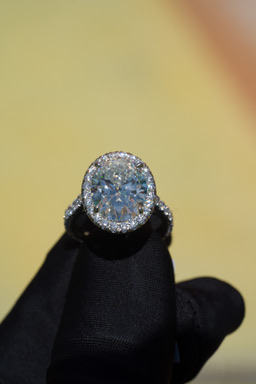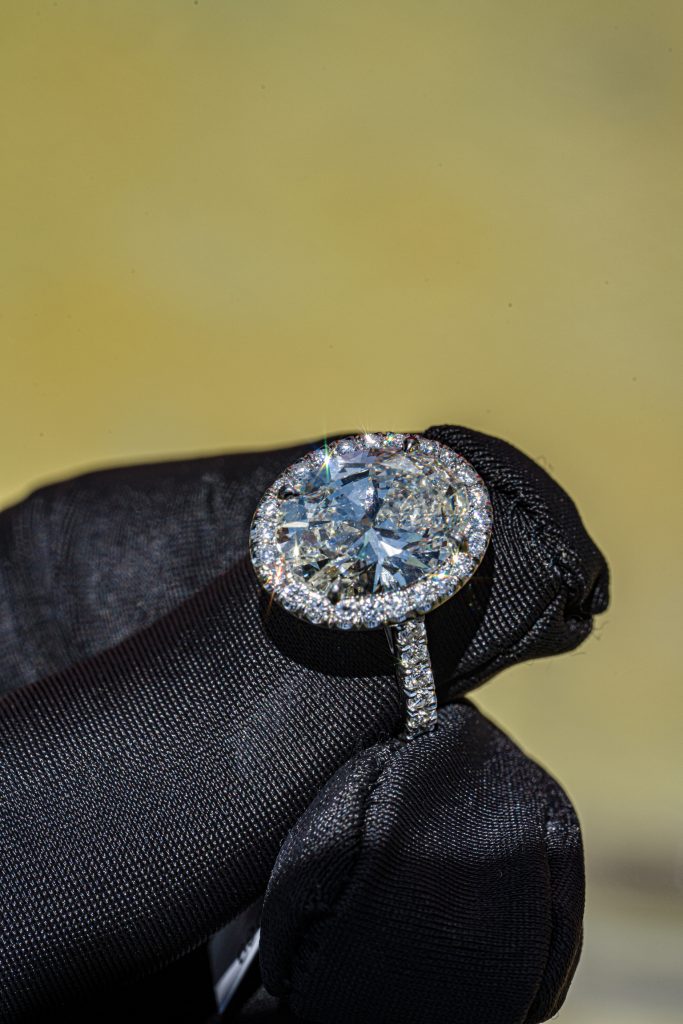Oval Diamond Halo and Pavé Engagement Ring

Oval diamond engagement rings, over the years, gained a lot of popularity. The oval shape makes the diamond appear larger, while its brilliance and fire make it an exquisite choice for an engagement ring. What about adding some extra sparkle? The halo and pavé setting can do just that. Furthermore, by combining these two settings with the oval diamond, you can create a breathtaking ring. And this leads us to Oval Diamond Halo and Pavé Engagement Ring.
Speaking of the halo and pavé setting! They are two popular techniques used in diamond ring settings to enhance the appearance of the center stone. The halo setting involves a ring of smaller diamonds, or other gemstones. To create the illusion of a larger stone, people place it around the center diamond. The pavé setting involves small diamonds or gemstones set closely together. Thus, creating a “pavement” of sparkle around the band. Together, the halo and pavé setting can add extra sparkle and dimension to any engagement ring.
First, the blog post will delve into the history and significance of the oval diamond cut. Oval diamonds have been around for centuries, but the modern oval cut didn’t emerge until the 1960s. The oval cut has become increasingly popular due to its versatility and the fact that it can make a diamond appear larger than it actually is. We will also explore the “Four Cs” of diamond quality – cut, color, clarity, and carat weight – to help readers choose a high-quality oval diamond.
And then we will also talk some other important things such as the benefits of combining both, examples and so on. Let us dive in!
The Oval Diamond Cut

The oval diamond cut has a long history that dates back centuries. However, the modern oval cut popular today didn’t exist until the 1960s. A diamond cutter named Lazare Kaplan made it happen. Kaplan is well-known for developing several diamond cuts. This includes the oval cut, which is similar to the round brilliant cut in terms of brilliance and fire.
The oval diamond cut is a modified brilliant cut. However, this means that it has same number of facets as the round brilliant cut but in an elongated shape. This elongated shape can make the diamond appear larger than it actually is. We can say it is one of the reasons why the oval cut has become so popular. The oval cut is also versatile, as it can be set vertically or horizontally depending on the preference of the wearer.
Many celebrities and public figures made the oval diamond cut popular. One of the most famous examples is the engagement ring given to Princess Diana by Prince Charles. The ring featured a large oval sapphire surrounded by diamonds, and it became one of the most iconic engagement rings in history.
The oval cut has a significant place in the world of diamonds and is highly sought after by diamond enthusiasts and collectors. The beauty and elegance of the oval cut have made it a popular choice for engagement rings and other fine jewelry.
Unique Characteristics of Oval Diamonds
Oval diamonds have several unique characteristics that set them apart from other diamond cuts. One of the most notable features of oval diamonds is their elongated shape. It makes them appear larger than other diamond cuts of the same carat weight. The elongated shape also creates an illusion of length, which can make the wearer’s fingers look longer and slimmer.
Another unique characteristic of oval diamonds is their brilliance. The oval cut modifies the brilliant cut by arranging the same number of facets as the round brilliant cut, but differently. This arrangement of facets helps to create an exceptional level of fire and brilliance. Therefore, making oval diamonds incredibly sparkly and eye-catching.
Oval diamonds also have a great deal of versatility. Ideally set either vertically or horizontally. And this depends on the preference of the wearer. Additionally, they are well-suited to a variety of engagement ring settings. This includes halo and pavé settings, which can further enhance their brilliance and make them even more stunning.
Finally, the elongated shape of oval diamonds can help to create a slimming effect on the finger. This is because the shape of the diamond draws the eye lengthwise down the finger, creating a visual illusion of length and slimness.
Tips for selecting a high-quality oval diamond

Selecting a high-quality oval diamond can be a daunting task, but there are a few key factors to consider that can help ensure you choose a beautiful and valuable diamond. Here are some tips for selecting a high-quality oval diamond:
Cut
The cut of a diamond refers to its shape and polish. A well-cut diamond will have maximum brilliance, fire, and sparkle. When you select an oval diamond, ensure it has a good or excellent cut grade because this will ensure that the diamond cutter has cut it to optimal proportions.
Color
The color of a diamond is graded on a scale from D (colorless) to Z (light yellow or brown). When selecting an oval diamond, aim for a color grade between D and G, as this will ensure that the diamond appears bright and white.
Clarity
The clarity of a diamond refers to the number of inclusions and blemishes that are visible under 10x magnification. When selecting an oval diamond, look for one with a clarity grade of SI1 or higher, as this will ensure that any inclusions or blemishes are not visible to the naked eye.
Carat weight
The carat weight of a diamond refers to its weight and size. When selecting an oval diamond, consider the size of the setting and your budget, as larger carat weight diamonds can be more expensive.
In addition to the Four Cs of diamond quality, there are a few other factors to consider when selecting an oval diamond. These include symmetry, polish, fluorescence, and certification. Look for a diamond with good symmetry and polish, as this will ensure that the diamond has been crafted with precision and care. Additionally, consider the level of fluorescence in the diamond, as this can affect its appearance under certain lighting conditions. Finally, look for a diamond that has been certified by a reputable diamond grading laboratory, such as the Gemological Institute of America (GIA) or the American Gem Society (AGS)
The Halo Setting
The halo setting is a popular style of engagement ring setting. It features a ring of smaller diamonds surrouning a larger center diamond. The designer sets the smaller stones in a pavé or micro-pavé style. Thus, creating a dazzling ring of light that enhances the overall brilliance. And of course reflecting the beauty of the center stone.
When paired with an oval diamond, the halo setting can create a stunning effect. This in turns accentuates the elongated shape of the diamond. The halo of smaller diamonds can also help to make the center diamond appear larger and more impressive. This is because the ring of smaller diamonds adds additional sparkle and brilliance. Thus, drawing attention to the center diamond and making it more eye-catching.
In addition to enhancing the beauty of the oval diamond, the halo setting also provides a practical benefit. Guess what: it protects the center stone. The smaller stones in the halo setting help to shield the center diamond from damage or scratches. Overall, it also adds an extra layer of security to the ring.
Pros of the Halo Setting:
- Added Sparkle: The halo of smaller diamonds in the setting creates an additional layer of sparkle and brilliance around the center diamond. This can make the engagement ring appear larger and more impressive, without the added cost of a larger center diamond.
- Protection: The smaller diamonds in the halo setting can help to protect the center diamond from damage or scratches, while also adding an extra layer of security to the ring.
- Customizable: The halo setting is highly customizable, allowing for a range of design options to create a unique and personalized engagement ring.
Cons of the Halo Setting:
- Maintenance: The pavé or micro-pavé setting used in the halo style can require more maintenance than other types of settings. The smaller diamonds can loosen or fall out over time, requiring regular maintenance and repairs to keep the ring looking its best.
- Cost: While the halo setting can enhance the overall brilliance and size of the engagement ring, it can also add to the cost. The additional diamonds and labor required to create the setting can make it a more expensive option.
- Less Focus on Center Diamond: While the halo setting can add to the overall sparkle and beauty of the engagement ring, it can also take away from the focus on the center diamond. This may not be ideal for those who want to showcase the unique beauty of their oval diamond.
The Pavé Setting
The pavé setting is a style of setting where small diamonds or other gemstones are set closely together. This creates a surface that appears paved with diamonds. The term “pavé” comes from the French word for “paved.” This means reflecting the way in which the stones arrangement in a continuous pattern.
When paired with a halo setting, the pavé setting can complement the overall design of the ring. Thus, adding additionalsparkle and brilliance. The small diamonds set in a pavé style can also help to draw attention to the center diamond, making it even more prominent and impressive. Additionally, the pavé setting can provide a sense of continuity between the halo and ring band. It creates a cohesive and visually appealing design.
Examples of Pave setting
There are several different styles of pavé setting, each with their own unique characteristics. Some popular styles include:
- French pavé: In this style, the small diamonds are set into a metal channel that is slightly raised above the surface of the ring. This creates a look of delicate, intricate detailing around the center stone.
- Micro-pavé: This style features very small diamonds set together. Therefore, creating a surface that is entirelycovered in diamonds. The effect is one of extreme sparkle and brilliance. If you are looking for a high-impact, statement-making ring.
- Bezel-set pavé: In this style, the small diamonds are set into tiny metal bezels that encircle each stone. This creates a look of continuity and smoothness, as the metal of the ring blends seamlessly into the diamonds.
Pros and Cons
While the pavé setting can add significant sparkle and brilliance to a ring, it does come with some potential downsides. One concern is that the small stones in the pavé setting may be more prone to falling out. They may also become loose over time. Additionally, the pavé setting can be more difficult to clean and maintain, as dirt and debris can easily become trapped between the stones. However, with proper care and maintenance, the pavé setting can be a beautiful and practical choice for those looking to add extra sparkle to their engagement ring.
The Oval Diamond Halo and Pavé Engagement Ring

Combining the halo and pavé settings can create a truly stunning engagement ring that enhances the beauty of the oval diamond. The halo setting can add an additional layer of sparkle and brilliance around the center diamond. The pavé setting, on the other hand, can create a seamless transition between the halo and the band of the ring. This then adds to the overall elegance of the design.
Combining these settings creates the illusion of a larger diamond. The halo of smaller diamonds can make the center diamond appear larger than it actually is. And the pavé setting can create a continuous band of sparkle that further enhances the size and brilliance of the ring. Oval diamond halo and pavé engagement rings offer a range of styles and design options to suit different tastes and preferences. These variations include differences in metal type. They are yellow gold, white gold, rose gold, and platinum. And differences in diamond size and placement.
One popular style of oval diamond halo and pavé engagement ring features a halo of smaller diamonds surrounding the center diamond, with pavé diamonds set along the band of the ring. The halo may also feature additional detailing, such as milgrain or filigree, to further enhance the beauty of the design.

